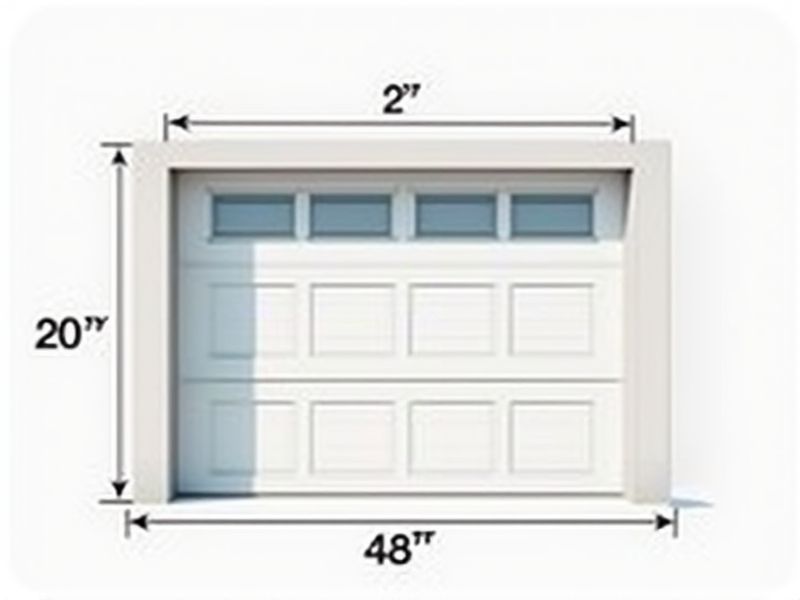
The standard dimensions for residential garage doors are typically 8 or 9 feet wide by 7 feet high for single-car garages, and 16 feet wide by 7 feet high for double-car garages. These measurements accommodate most passenger vehicles and allow for easy entry and exit. If you need to store larger vehicles such as trucks or SUVs, you can find garage doors up to 10 or 12 feet tall. Always measure your garage opening before ordering a door to ensure the best fit for your space and needs.
Widths Typically Range From 8 To 20 Feet
Garage doors commonly have widths that vary between 8 to 20 feet, accommodating a wide range of vehicle sizes and designs. Residential garage doors generally fall within the 8 to 16 feet range, while commercial options can extend up to 20 feet to allow for larger vehicles or equipment. The standard height typically measures 7 to 8 feet, ensuring ample clearance for most vehicles. Your choice of garage door size can significantly impact functionality and accessibility, making it essential to select the right dimensions for your specific needs.
Standard Heights Are 7 Or 8 Feet
Garage doors typically adhere to standard heights of 7 feet (84 inches) or 8 feet (96 inches), ensuring compatibility with most residential and commercial structures. These dimensions accommodate a variety of vehicle sizes, from compact cars to larger SUVs and trucks. If you're planning a new installation or replacement, opting for these standard heights can streamline the process and reduce costs associated with custom sizes. Always consider local building codes and regulations to ensure compliance when selecting your garage door height.
Double Doors Usually Are 16 Feet Wide
Double garage doors typically measure 16 feet in width, which provides ample space for two vehicles. These doors are designed for durability, often constructed from materials such as steel or fiberglass, ensuring long-lasting performance. The standard height for these doors is usually 7 feet, suitable for most SUVs and trucks. When considering installation, remember that proper insulation can enhance energy efficiency, reducing heating costs by up to 20%.
Custom Sizes Available For Non-Standard Openings
Garage doors can be customized to fit non-standard openings, with options available in various sizes to meet your specific requirements. Standard widths typically range from 8 to 18 feet, while standard heights vary from 7 to 9 feet. For unique dimensions, manufacturers offer bespoke solutions that can accommodate openings as narrow as 3 feet or as tall as 20 feet. Choosing a custom garage door not only enhances the aesthetic appeal of your home but also improves functionality and efficiency.
Residential Doors Vary From Commercial Sizes
Residential garage doors typically range from 7 to 8 feet in height, while commercial doors can extend up to 14 feet. The standard width for residential models usually spans 8 to 18 feet, as opposed to commercial versions which can be even wider, accommodating vehicles and equipment. Material options for residential doors include steel, wood, and fiberglass, with varying insulation levels, while commercial doors often prioritize durability and security with materials like aluminum or heavy-duty steel. When selecting your garage door, consider both the size and material to ensure it meets your specific needs and local building codes.
Panel Styles Influence Door Dimensions
Panel styles significantly influence the dimensions of garage doors, with standard heights typically ranging from 7 to 8 feet and widths from 8 to 18 feet. Traditional raised panels offer a classic aesthetic, while modern flush panels cater to contemporary tastes, impacting both the visual appeal and structural design of the door. Customizations, such as the number of sections and panel orientation, can alter overall size and functionality. When selecting a garage door, consider how panel styles align with your specific space requirements and architectural preferences.
Adjustments Might Be Necessary For Garage Openers
For optimal garage door functionality, regular adjustments to garage openers are essential, particularly if you're experiencing inconsistent opening or closing. Standard garage door openers typically have force settings and travel limits that may require recalibration after extended use. Manufacturers recommend checking these settings at least twice a year to maintain safety and efficiency, as an improperly adjusted opener can pose risks. By ensuring your garage door opener is finely tuned, you enhance not only the longevity of your door system but also the security of your vehicle and belongings.
Regional Building Codes Affect Dimensions
Regional building codes significantly impact garage door dimensions, ensuring compliance with local safety and aesthetic requirements. For instance, many areas mandate a minimum width of 8 to 9 feet for single-car garage doors and up to 16 feet for double-car options, accommodating various vehicle sizes. Compliance with these regulations can influence your choice of garage door, affecting both installation and functionality. Knowing the specific codes in your region can save you from costly modifications and enhance the overall value of your property.
Insulation Options Impact Thickness
The insulation of a garage door significantly impacts its thickness, with options typically ranging from 1.5 to 2 inches for optimal thermal performance. Higher R-values, which indicate better insulation efficiency, are often achieved with polystyrene or polyurethane materials, providing energy savings of up to 20% in heating and cooling costs. An insulated door not only minimizes heat loss during colder months but also maintains cooler temperatures in summer, enhancing your garage's usability. When selecting your garage door, consider these insulation options to balance both energy efficiency and structural integrity.
Clearance Space Required For Installation
The standard clearance space required for garage door installation is typically 12 to 18 inches above the door opening. This space allows for proper track installation and ensures smooth operation of the door. For side clearance, at least 3 to 6 inches on each side of the door frame is recommended to accommodate the vertical tracks. Adequate clearance not only ensures functionality but also extends the lifespan of your garage door system.
